#Soviet-era Vessel
Text
INS Vikramaditya the First Indian Aircraft Carrier to Get Operational by the End of January 2023

INS Vikramaditya, India’s first aircraft carrier is going to join the Karwar Naval base by the end of January 2023. Prime Minister Narendra Modi is going to address in March the Combined Commanders Conference, where the hulk of battleship will be the center of attention. Sea trials will begin soon along with that for INS Vikrant, its successor leaving an impact in the Indo-Pacific waters. INS Vikramaditya is weaponized with Russian MiG-29K fighters onboard.
As for INS Vikrant, a landing of maritime LCA and test case scenario is also being considered this year. With US F-18 and French Rafale-M, a decision to bring forth 8 trainers and 26 maritime strike fighters for INS Vikrant will also take place. The Indian Navi submitted to the Defence Ministry the trial reports for the two operational aircraft carriers. The Modi government will assess the performance of the battleships and then finalize its call.
Both the carriers will remain on the western coast of India until the huge war machines find a place on a jetty at the eastern seaboard of Vishakhapatnam. But the aircraft carriers may be accommodated on a jetty at Kattupalli Port in north Chennai as the Indian Navy is planning to lease it with another jetty at Campbell Bay of Andaman and Nicobar Islands. INS Vikramaditya and INS Vikrant will empower Indian national security.
Plans are in motion as the strike forces will go well beyond the Arabian Sea and the Bay of Bengal to India-Pacific and even further. The Indian Ocean could be patrolled by three aircraft carriers of Chinese Navi by 2025, the two war machines will play in defense and deepen cooperation with PLA Navy and other major naval giants in the region.
The Indian Ocean is already being mapped by the PLA strategic surveillance vessels including the five ingress straits and 90-degree ridge to South China for maritime operations in the future. India has also been offered by Beijing naval cooperation for the littoral states surrounding the Indian Ocean. They have a proposal to gift the country off-shore patrol vessels the same that was offered to Seychelles. INS Vikramaditya and INS Vikrant will help India to secure the eastern seaboard from Africa to the Australian west coast.
Visit: - https://www.jsbmarketresearch.com/news/news-ins-vikramaditya-indian-aircraft-carrier
Follow us on social handles:-
Twitter: - https://twitter.com/JSBMarket/status/1615659928043282439?s=20&t=-ISRfa04i9qG6SKFphzuTQ
LinkedIn: - https://www.linkedin.com/posts/jsbmarketresearch_insvikramaditya-indiannavy-aircraftcarrier-activity-7021425880765730816-y0t8?utm_source=share&utm_medium=member_desktop
Pinterest: - https://pin.it/2DifLvw
Facebook: - https://www.facebook.com/profile.php?id=100088868246670
Instagram: - https://www.instagram.com/p/CnjaiJ6qLWJ/?utm_source=ig_web_copy_link
YouTube: - https://youtube.com/shorts/DoHLZehga94?feature=share
#Indian Navy#INS Vikramaditya#Aircraft Carrier#Sailing#January#Refurbished#Soviet-era Vessel#MiG-29K Fighter Jets#Air Defense#Power Projection#Karwar Base#India#jsbmarketresearch#swotanalysis#marketresearchreports
2 notes
·
View notes
Text
Ukraine’s daring attack on a major Russian warship in occupied Crimea in the small hours of Dec. 26 was one more episode in Kyiv’s strategy to deny Russia control over the Black Sea. With most of its ships driven out of its home port in Sevastopol, the Russian Black Sea Fleet can no longer find safe haven anywhere along the Crimean Peninsula. All ports there are now vulnerable to attack.
The Institute for the Study of War tells the story with data, showing that Sevastopol saw a steady decline in the number of Russian naval vessels in port between June and December 2023; by contrast, Novorossiysk on the Russian mainland farther east showed a steady gain. While Russia has been going all-out to attack Ukraine’s infrastructure, its risky move to deploy ships and submarines armed with Kalibr missiles in the Black Sea is exposing them to potential Ukrainian attack. It is a tacit acknowledgment that Russia can no longer depend on Crimean ports and launch sites.
Ukraine’s success has been due to domestically produced missiles and drones, sometimes launched using Zodiac boats or jet skis. But its most potent attacks have come from the air, where Ukraine has used its Soviet-era fighter aircraft to launch both domestically produced and NATO-supplied missiles. These attacks have taken place with the protection of Ukraine’s advanced air defenses—including newly supplied foreign ones—which are regularly shooting down the majority of Russian missiles and drones destined for Ukrainian targets.
Ukraine thus has made significant strides denying Russia control of both the sea and airspace over and around its territory, thereby preventing the Russian Navy and Air Force from operating with impunity. But is that enough for Kyiv to win? To many Western observers, victory doesn’t seem possible in the face of wave after wave of Russian troops grinding down Ukrainian defenders. Ukraine’s strategy to deny Russia free use of its sea and airspace may be working, but as things stand, it cannot defeat the Russian army on the ground, nor can it defend against every missile striking civilian targets.
Indeed, the current conventional wisdom in large parts of the West is that Ukraine is losing the ground war, leaving no pathway to victory for the country as Russia pounds Ukrainian civilians into submission. Kyiv might as well call for a cease-fire and sue for peace.
The trouble with this scenario is that it spells defeat not only for Ukraine, but also for the United States and its allies in Europe and Asia. It would embolden both Russia and China to pursue their political, economic, and security objectives undeterred—including the seizure of new territory in Eastern Europe and Taiwan.
But is the conventional wisdom right—or does Ukraine’s clever success at sea and in the air suggest that a different outcome is possible? Perhaps the Russian army can be defeated by making use of Ukraine’s willingness to fight in new ways. If you asked a U.S. military professional, the key to dislodging the Russians is to subject them to relentless and accurate air attacks that are well synchronized with the maneuver of combined arms forces on the ground. While the Ukrainians are admirably using the weapons at hand to strike Russian forces both strategically, as in Crimea, and operationally, as in hitting command and logistics targets, success at the tactical level has remained elusive. To achieve a tactical breakthrough on the ground front that leads to operational and strategic success, they will need to be more effective from the air.
For power from the air to be decisive in 2024, the Ukrainian Armed Forces must create temporary windows of localized air superiority in which to mass firepower and maneuver forces. Given the Ukrainians’ success in denying their airspace to Russia at points of their choosing, such windows are possible using the assets they already have at hand. More and better weapons tailored to this scenario would make them more successful across the entire front with Russia.
Gen. Valery Zaluzhny, the commander of the Ukrainian Armed Forces, acknowledges that to break out of the current positional stalemate—which favors Russia—and return to maneuver warfare, where Ukraine has an advantage, Ukrainian forces need air superiority, the ability to breach mine obstacles, better counter-battery capability, and more assets for electronic warfare. Specifically, he argues for three key components. First, armed UAVs that use real-time reconnaissance to coordinate attacks with artillery (which could include properly armed Turkish-built TB2s, MQ-1C Gray Eagles, MQ-9 Reapers, or bespoke cheap and light UAVs capable of employing the necessary weapons). Second, armed UAVs to suppress enemy air defenses, as well as medium-range surface-to-air missile simulators to deter Russian pilots. And third, unmanned vehicles to breach and clear mines.
Although the technologies are new, this combination of capabilities recalls the method U.S. and allied NATO forces practiced during the Cold War in West Germany to confront numerically superior Warsaw Pact ground forces protected by layered air defenses. The Joint Air Attack Team (JAAT) was developed to synchronize attack helicopters, artillery, and close air support by fighter planes to ensure a constant barrage of the enemy in case of a ground force attack. Pooling NATO assets in this way was designed to give the alliance’s forces the mass, maneuverability, and flexibility needed to overcome superior numbers, avoid a war of attrition, and escape the type of bloody slugfest that characterizes the current stalemate in Ukraine.
In Ukraine’s case, a modernized JAAT would encompass, among many things, armed UAVs carrying Maverick and Hellfire missiles, loitering munitions, precision-guided artillery shells, and extended-range standoff missiles fired by aircraft. These systems would be coordinated in an electromagnetic environment shaped by Ukrainian operators to dominate the local airspace, saturate the battlefield with munitions, and clear mines to open the way for a ground assault. This updated JAAT—let’s call it electronic, or eJAAT—would create a bubble of localized air superiority that would advance as the combined arms force advances under the bubble’s protection.
Given Russia’s willingness to endure significant casualty rates, the eJAAT could be even more effective on defense: Massing firepower against advancing troops through an eJAAT might result in a stunning rout of the attackers, opening opportunities for Ukraine to strategically exploit the sudden change of fortunes.
Zaluzhny has made it publicly clear that “the decisive factor will be not a single new invention, but will come from combining all the technical solutions that already exist.” Like all good commanders, Zaluzhny is painfully aware that the 2023 campaign didn’t work as well as he had intended. Even so, and to their advantage, the Ukrainians have clearly demonstrated their innovative talents, willingness to exploit Western methods, and total commitment to victory. U.S. and European assistance to work with them on how to better manage operational complexity and combine technology, information, and tactics in more dynamic ways, coupled with security assistance tailored to the eJAAT approach, would return movement to the now-static battlefield and give Ukraine a fighting chance.
If Ukraine can achieve the momentum in the ground war that evaded it during its failed summer offensive, Kyiv will have a real pathway to victory. That pathway will run through Ukraine’s demonstrated prowess at sea and in the air, joined to an embrace of a sophisticated combination of techniques on the ground. It will be a pathway to victory not only for Ukraine, but also for the United States and its allies.
81 notes
·
View notes
Text
Retro-futuristic espionage, a love letter to the vintage, and living music: JAZZPUNK
It's almost impossible not to find something new every time you replay Jazzpunk. Saxophonist pies, corporate espionage, comedy and cybercrime: few videogames—if there's more than just one—gather these characteristics and make them dance in a way as harmonious as it does. This adventure game transports whoever touches it to the late 1950s during an alternate Cold War, where the north of America has become the United Prefectures of Japanada and robots are a common sight on Earth.
Its developers, Luis Hernandez and Jess Brouse, initially released the game in 2014 with a total of 10 chapters. Posterior to that, in 2016, they released another edition of the game, both for PC and PlayStation 4 consoles, with content never seen before. While it didn't add more chapters to the game, it did add a DLC 'level' and amplified the preexisting ones.
The mute protagonist of this exhilarating experience, Polyblank, serves as a vessel for the player to be transported to this strange world. His adventure begins in an abandoned subway station where he meets with his coworker, Secretary IX; and boss, The Director. The latter assigns him missions, like infiltrating the Soviet Consulate, extracting a bio-engineer cowboy's artificial kidney, going on vacation and fighting against his nemesis, The Editor.
It's only to be expected that in each of these sections you can find side quests—I mean, would it really be as good a game if you couldn't eat a pigeon or travel in space and time?—. Though, different to other games, these are made to distract the player from the main task at hand and force it to explore the (almost) open world. There's no logic games, or puzzles, but there are weird gadgets and exotic stores that, without any doubt, make whoever sees them stop for a moment to laugh at them.
It's a game plagued with references to its epoch, as can be appreciated in its art and the architectonic style of its scenes, perfectly fit for vintage enthusiasts; though it is also full of references to the 21st century's earliest years, like its videogame scene and popular culture.
Leaving this aside, there's another crucial aspect that would be a crime not to point to: its music. If the Jazzpunk soundtrack could be described as anything, it would be a loving fusion of the two eras mentioned earlier. Luis Hernandez, one of its developers, gave himself the task to create it. He used old tape recorders and analogic homemade synthesizers; not using a computer for anything but to introduce the music into the game. It's loud, out of tune and, instead of following the player, it's stuck to objects. It perfectly complements the vibrant graphics and makes the wacky world you find it in alive and tangible.
Nowadays, almost three years of knowing Jazzpunk, I'm still surprised by tiny details I hadn't seen before (and that's considering I always think that then, finally, I'll have seen it all). If you are looking to spend a good three hours—or more, if that's how bored you are—; the comical plot, interesting references and peculiar soundtrack of this game might be your solution.
15 notes
·
View notes
Text
Gela Mikava
Gela Mikava is a Georgian visual artist whose unique approach to artistry centers on repurposing Soviet-era cotton fabric stretch ceilings as his canvas of choice. In a world where materials are often discarded thoughtlessly, Mikava sees these ceilings as vessels of history, carrying the weight of generations' stories, emotions, and memories.

3 notes
·
View notes
Text

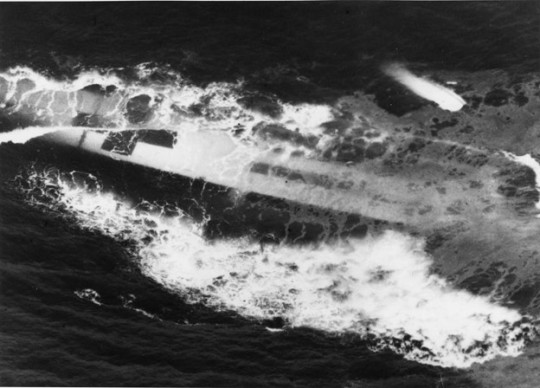




Life and Death at the Gate
At dawn on Sunday, 25 June 1950, the North Korean army crossed the 38th parallel supported by massed artillery fire. With the support of the Soviet Union the invasion was based on a false claim by North Korea that South Korean troops had attacked first. The real aim of the invasion was to take by force and subjugate South Korea under rule of the current North Korean leader's grandfather and his sham democracy. Condemned by the Free World, the invasion drew the first ever response by the United Nations, primarily supported by U.S. troops and aid. The war has technically never ended, and it resulted in millions killed and over 100,000 U.S. servicemen wounded or killed in action. In recognition of the coming carnage, a short time after the invasion, the World War II era hospital ship USS Benevolence (AH-13) was towed from a mothball fleet to Mare Island Naval Shipyard (MINS) in the San Francisco Bay Area to be taken out of mothballs and recommissioned. The US Navy Hospital Ship Benevolence would never make it to Korea. She tragically sank just minutes outside the Golden Gate while returning from sea trials.
Benevolence departed Mare Island at 0800 on 25 August 1950 for limited sea trials following recommissioning. Eight and a half hours later the fully loaded freighter SS Mary Luckenbac passed under the Golden Gate Bridge in thick fog bound for Philadelphia, Pennsylvania. Visibility was reported to vary from 300 to 400 yards. Radar had become common place by the 1950’s, but the Mary Luckenbac‘s radar had malfunctioned and was turned off. As the Mary Luckenbac passed under the bridge, she was on a collision course with the Benevolence returning from her sea trials. Aboard the Benevolence the radar was on and operating, but for some reason the crew was unaware of the approaching freighter. Both ships had bow lookouts posted and were operating their fog horns, but their combined closing speeds of 27 knots would doom the Benevolence. At an estimated 1,000 yards bow lookouts on the Benevolence sighted the bow wave of the approaching freighter. Benevolence began blasting the emergency signal on the ship’s horn as both ships attempted evasive action. It was too late, within three minutes the freighter slammed into the hospital ship raking her compartments open along the port side.
Following the collision both ships vanished into the fog. Unaware of the extent of the damage to his ship, Captain Barton E· Bacon on board the Benevolence gave no orders to prepare to abandon ship. However, within 5 minutes his ship’s main deck had sunk to sea level at the bow and she was listing 45 degrees, too far over to launch the lifeboats. The Benevolence had managed to transmit a message requesting emergency assistance just after the collision and then radio contact was lost. Twenty minutes later the Benevolence rolled over and sank in the shipping channel between Pt. Bonita and Seal Rocks. Five Hundred and twenty-five men and women went into the frigid water as the outgoing tide scattered them further out to sea. As word of the disaster spread a small armada of fishing boats, yachts, coast guard and naval vessels began scouring the seas in the thick fog looking for survivors. Survivors would continue to be found and pulled from the sea for nearly two days and as they were landed by rescue ships the Red Cross handed them a carton of cigarettes and the Service’s gave them booze. In the end eleven Navy, ten Military Sea Transportation Service and two MINS tradesmen were lost.
The Benevolence laid just beneath the waves in the south shipping channel as a hazard to navigation for sixteen months as separate courts of inquiry were held by the Navy and Coast Guard on Treasure Island and in San Francisco respectively. While the inquiries were underway MINS was directed to study the possibility of salvage. A no cure no pay request for proposals was sent to Bay Area salvage firms to evaluate the feasibility of salvage. A tanker suffered a minor collision with the Benevolence hulk, before MINS officials determined that salvage was not feasible, and the decision was made to remove the hazard with explosives. When you visit the USS San Francisco memorial near Lands’ End on the 49 Mile Scenic Drive and look out to sea you are overlooking the site of the Benevolence sinking.
#mare island#naval history#san francisco bay#us navy#vallejo#Korean War#Mary Luckenbac#Benevolence#Hospital Ship#Golden Gate#sink#collision#fog#survivor#drown
2 notes
·
View notes
Text
Ukrainian forces discovered that Russia was using an artillery piece which had been designed in the mid 1940s – when Donald Trump was born. Of course Ukraine destroyed this gun which probably belonged in a Cold War museum.
In the Kupiansk sector, Ukraine’s Steel Border [Stalevyi Kordon] assault brigade, consisting of border guard officers, used a suicide drone to destroy an obsolete Russian gun, which was designed in the mid-1940s.
The relevant video was posted by the Ukrainian Internal Affairs Ministry on Facebook, an Ukrinform correspondent reports.
“The Steel Border brigade’s suicide drone hunted down an obsolete gun,” Ukrainian Internal Affairs Minister Ihor Klymenko noted.
In particular, during an aerial reconnaissance, Ukrainian defenders detected the Soviet-era S-60 anti-aircraft artillery system with the 57mm AZP-57 gun, which was designed back in the mid-1940s, in enemy positions.
This article, authored on June 19, 1999, called it "obsolete" – way back then. 🤣
S-60 / Type 59 57mm Anti-Aircraft Artillery
Russia has launched what seems to be a counteroffensive in eastern Ukraine. The objective apparently is to take pressure off of Ukraine's advance in the south.
The Russians are hurting down south and especially on the Black Sea where a Russian missile carrier was put out of commission last week. The funny thing about the severe damage to the Pavel Derzhavin is that it could have hit a Russian mine. 😝
Anton Gerashchenko, an Interior Ministry spokesman, in a Wednesday afternoon statement said Ukrainian intelligence sources confirmed the fact of the explosion but the cause was unknown. He suggested that it was possible that a Ukrainian missile or long-range drone was responsible for the strike.
Serhiy Bratchiuk, head of the regional defense command in Ukraine’s western Odesa region, in statements carried by local media said that according to his sources the most likely cause was that the Pavel Derzhavin had struck a Russian sea mine protecting the Sevastopol harbor. Ukrainian intelligence operatives were still investigating, he said.
Russian language Wikipedia had, by Wednesday evening, written the ship off as a total loss and closed the page dedicated to the vessel.
News from Ukraine is being overshadowed by news from the Middle East for obvious reasons. Putin is happy to have a distraction to take the international spotlight off of his war crimes in Ukraine.
If you live in the United States, contact your member of the House of Representatives and urge them not to give in to the dysfunction caused by the Putin Caucus which includes the most extremist anti-democracy House members. Do it today!
Find Your Representative | house.gov
#invasion of ukraine#stand with ukraine#s-60/type 59 57mm anti-aircraft artillery#kupiansk#pavel derzhavin#sevastopol#vladimir putin#russia's war of agression#us house of representatives#contact your house member#павел державин#черное море#владимир путин#путин хуйло#путин - военный преступник#россия проигрывает войну#устаревшая военная техника#руки прочь от украины!#геть з україни#вторгнення оркостану в україну#деокупація#україна переможе#куп'янськ#севастополь#крим це україна!#слава україні!#героям слава!
3 notes
·
View notes
Text

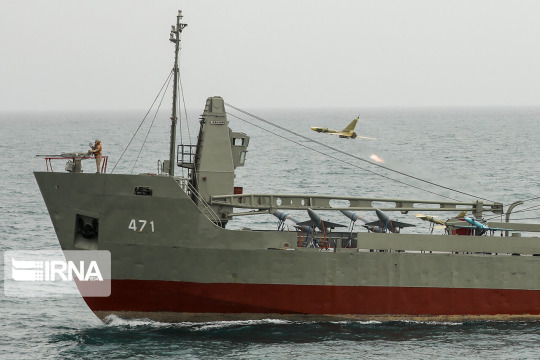
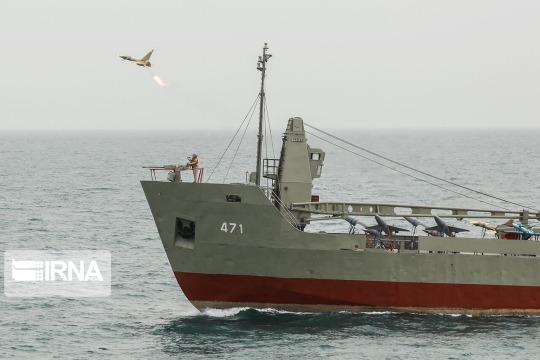
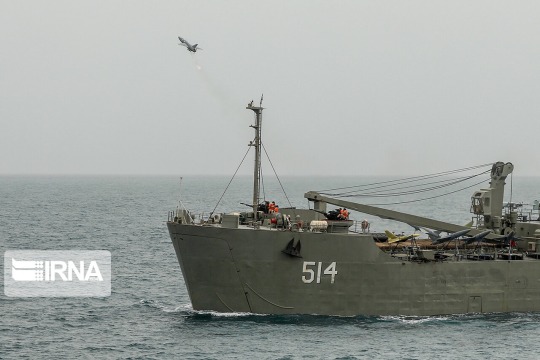
The newly established “drone carrier division” of the Iranian Islamic Navy, which consist of naval vessels equipped with catapults for iranian-made attack drones.
Pictured: Soviet-era Kilo-class submarine Tareq, auxiliary ship Delvar (471), and landing ship Lavan (514).
35 notes
·
View notes
Photo




“I once heard It’s unlucky to garnish a drink with only two olives.”
“Oh, is it? You know who would tell such a story?”
“Who?”
“Why, the people who sell the olives, dear Zosja. It is their business, after all. Now let us get down to our own business. ”
The once-lost classic ‘Goncharov’ is enjoying a resurgence and is ripe for inspiration for cocktails, with Katya and Sofia being an excellent starting place. From the prescient and nuanced exploration of a post-Soviet Europe we unite one of the premier vodkas of the modern post-Soviet era, the Ukranian Khortytsa, with the truly one of a kind Naples-local Liquore Strega. It sets itself apart from other Italian aperitifs and bitters with a woodsy sweetness, yet not quite as fir-like as the alpine liquors. It truly lives up to its name, mysterious and bewitching. It marries beautifully with the herbal honeyed notes of Bittermens Krupnik.
But as we know, red is a motif present in (most) cuts of the film surrounding Katya, and so Sofia’s companion drink is a charming, diminutive, and beguiling little aperitif take on the Negroni, a cousin perhaps to Tristian Willey’s “TiNegroni”. However, much like Sofia can hold her own throughout the drama and tragedy of this legendary film, with proper navy-strength gin(defined as being between 54.5%-57% ABV) this will wake up more than just your appetite.
чистый ведьма/Chistaya Ved’ma [Perfect Witch] | ABV: 33.3% | Yield: 3.60 fl oz | Aperitif, Martini, Stirred
Place Mixing Glass and Serving Glass in Freezer
2 fl oz or 60ml Eastern European Vodka, Stored in Freezer
.75 fl oz or 22.5ml Liquore Strega
2 dashes Bittermens Krupnik Bitters
3 drops saline solution
Take your ice pick and crack plenty of ice into your mixing vessel. Stir until the vessel begins to condense and fog up, the base is cold to the touch, or the ice feels “loose”. Strain into prepared glass -- preferably a Nick & Nora, small coupe, or small v-stem, and garnish with 2 Castelvetrano olives.
Piccolo Negroni | ABV: 31.62% | Yield: 1.93 fl oz | Aperitif, Negroni, Built
0.75 fl oz or 22.5ml Navy Strength Gin, stored in freezer
0.50 fl oz or 15ml Campari, stored in fridge
0.50 fl oz or 15ml Antica Formula Vermouth di Carpano*, stored in fridge
Combine liquor in a small glass with 1 cracked ice cube and give a very quick stir just to integrate and slightly dilute the components. Strain into a cordial or sherry glass, about 2 oz in capacity. Take swath of orange peel and twist over drink.
*Cocchi Storico Vermouth di Torino or Punt e Mes are both also good, but the more vanilla notes present in Antica appeal to me here. These can often be found in half-sized bottles.
#goncharov#goncharov (1973)#fandom cocktails#katya x sophia#strega#negroni#aperitif#cocktails#goncharov cocktails#katya goncharova#gonchposting
10 notes
·
View notes
Text

@musemilitia said: "Kacchan!! Kacchan!! Kaminari-kun and I were trying to figure out what the top three strongest military weapons in the world would be." Izuku explained before adding, "do you have any ideas about that?"

Fuck. That sounded like a painful conversation between two dumbasses who knew nothing about military history. It was a good thing he hadn’t overheard or else he would have likely burst a blood vessel.
“Do I have ideas about military weapons...?!” he echoed, clearly offended that Deku would even ask that. Nearly all of his attacks or support items were named after historical military weapons. “That’s the dumbest fuckin’ question I’ve heard leave your mouth in a while.”

“Listen up, nerd!” Katsuki declared. “Since listing off names of different nuclear weapons is too fuckin’ easy, I’m gonna give you a short list of artillery weapons that’ll kick anyone’s ass.”
“The Soviet-era 2S7M Malka Howitzer is the most powerful artillery system with 203 millimeter caliber rounds,” he said without pausing to think. It was just information he knew from memory. “It’ll easily knock helicopters and fighter jets out of the sky and tear holes in tanks.”
“.950 JDJ is the largest caliber rifle in existence right now,” he added. “There’s a .950 mm-caliber cartridge in that fucker.” He paused. “And then there’s the Eryx shoulder-launched rocket launcher with a 134 mm caliber warhead on the missile. That will level most of a damn city.”
Do not challenge him on military weapons trivia, Deku. You know better.
#Katsuki replies#he's a military history buff#he knows too much about weapons#headcanon#aka he's a freaking nerd#musemilitia#tw mention of guns
4 notes
·
View notes
Text
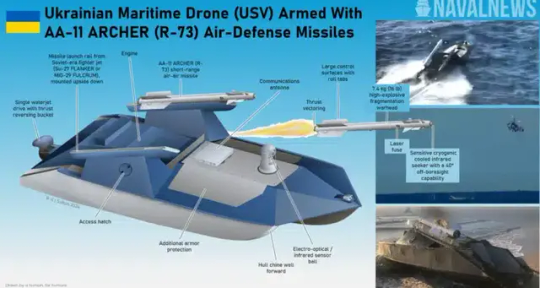
Ukraine Has World’s First Navy Drone Armed With Anti-Aircraft Missiles
Ukraine's uncrewed surface vessels (USVs) are dominating naval combat in the Black Sea.
Yet they have, until now, been particularly vulnerable to aircraft. So RuZZian defenses have emphasized using helicopters and fighter jets to stop them.
Now a version armed with two repurposed air-air missiles could change the tide again.
H I Sutton 21 May 2024
The war in Ukraine has removed any remaining doubts that drones are transforming warfare.
In the naval arena, Ukraine’s maritime drones are leading the world in terms of combat application.
These explosive-laden craft first challenged, and then changed, many preconceptions.
Now Ukraine has deployed an entirely new category of maritime drone, one armed with air defense missiles.
Until now Ukraine’s maritime drones (USVs) have been most vulnerable to aircraft.
They are essentially defenseless against a helicopter armed with a machinegun. Now, with some USVs armed with potent air-defense missiles,
RuZZian pilots may think twice about approaching them.
In practice this is the first such air-defense USV in the world. Other country’s manufacturers have explored giving USVs some form of air defense.
But this system is the first fielded operationally, and indeed, the first in combat.
The drone is armed with two missiles
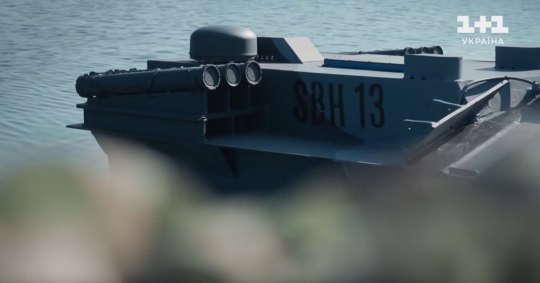
The new USV (uncrewed surface vessel) is distinct from previously observed types, featuring a new wider hull.
This allows two missiles to be carried side-by-side.
It is armed with two R-73 air-air missiles. This parallels a trend on land with Ukraine increasingly leveraging missiles designed for one system on another.
At least one vintage Osa air-defense system has also been equipped with R-73s, and British supplied ASRAAMs have also been used as ground-based systems.
These mix-match systems are informally termed ‘FrankenSAMs’ after Frankenstein’s monster.
All the same these missiles now allow the vessel to pose a real threat to aircraft.
The R-73 missile, known by the NATO reporting name AA-11 Archer, is a Soviet-era short-range air-air missile.
Carried by fighters like the MiG-29 Fulcrum and Su-27 Flanker, the missile was arguably the best dogfighting missile in service.
It was highly agile and had an impressive seeker with 40 degrees off-boresight capability.
This meant that it could be launched against a target with was not directly in front of the plane.
And to air targeting, the seeker was slaved to a helmet mounted sight.
In the 1980s this was more advanced than the equivalent NATO.
Today the latest versions of the Sidewinder, or the ASRAAM, IRIS-T, are arguably more potent.
But the R-73 remains a potent system.
The trade-off for surface launch will be range.
Even if the vessel can detect the aircraft at range, the missile itself will have around half the range compared to if it was air launched.
For the R-73 this means a range of around 15 km (9 miles).
In practice, the detection range of the vessels’ electro-optical devices is likely to be the main limitation.
Potential Roles and Impact
The missiles provide the drone with a degree of self-protection.
The craft is now better defend itself against RuZZian helicopters and fast jets.
One or two of the FrankenSAM USVs mixed in with a larger force of regular USVs may be enough to inhibit RuZZian attempts to interdict them.
The system also opens the possibility of using them to ambush RuZZian aircraft as they take-off or land on Crimean air bases.
The USVs can sit off the Crimean Coast and pick off the aircraft as they approach unawares.
There is at least circumstantial evidence to suggest that this may have already been done.
Many USVs manufacturers around the world are already emulating Ukrainian advances.
And there have been several proposals for air defense equipped types even before the RuZZo-Ukraine War.
But the emergence of this type, and its apparent utility, is likely to make those proposals be taken more seriously.
Posted by : H I Sutton
H I Sutton writes about the secretive and under-reported submarines, seeking out unusual and interesting vessels and technologies involved in fighting beneath the waves. Submarines, capabilities, naval special forces underwater vehicles and the changing world of underwater warfare and seabed warfare. To do this he combines the latest Open Source Intelligence (OSINT) with the traditional art and science of defense analysis. He occasionally writes non-fiction books on these topics and draws analysis-based illustrations to bring the subject to life. In addition, H I Sutton is a naval history buff and data geek. His personal website about these topics is Covert Shores (www.hisutton.com)
0 notes
Text
When U.S. officials complained at the annual Shangri-La Dialogue in Singapore early this month that a Chinese naval vessel had dangerously cut off a U.S. destroyer in international waters as it passed through the Taiwan Strait, China’s defense minister had a ready-made answer for how such hazards could best be avoided in the future.
“For China, we always say mind your own business, take good care of your own vessels, your fighter jets, take good care of your own territorial airspace and waters,” said Gen. Li Shangfu. “If that is the case, then I don’t think there will be future problems.”
The United States has long used the standard, internationally ratified definition of what constitutes “innocent passage” to justify sending warships through the territorial waters of many other nations, and, in the case of China, patrolling the seas close to the Chinese coast. The same has been true of U.S. military aircraft flying near China in international airspace.
For China, which in recent years has acquired ever more impressive means to push back with a powerful naval fleet and sophisticated air force of its own, the U.S. position amounts to what Beijing calls “hegemony of navigation,” by which it seems to mean taking maximal advantage of international rules that were largely conceived in the spirit of Western legal traditions and enacted during a long era of scarcely challenged Western power.
From the instant one looks more closely, though, things become more complicated. For one, China has ratified laws of the sea that it now complains about, and the United States, remarkably—and I am tempted to say to its shame—has not.
Furthermore, China frequently commits the very same acts that it objects to close to its shores. Most of these receive little international attention, such as sending warships into disputed waters around the Senkaku Islands, also claimed by Japan, or firing ballistic missiles into waters that form part of that country’s exclusive economic zone. The Chinese Navy has also trailed U.S. Navy vessels into seas close to Okinawa, Japan, where a Chinese submarine surfaced undetected near U.S. warships during drills there just to prove that it could. Chinese warships have also exercised the right of innocent passage close to U.S. shores.
For Americans, this shadow game has been powerfully brought home by two recent events. The first, which I would characterize as clumsy or ill-advised, involved the west-to-east transit of U.S. continental airspace by a Chinese balloon that reportedly carried sophisticated electronic signals-capturing equipment. One comedian joked aptly afterward that the Chinese could have at least painted the thing blue to blend in with the sky. The incident may have set U.S.-China relations back by at least half a year, prompting U.S. Secretary of State Antony Blinken to postpone his first official visit to Beijing at a time of badly needed high-level communication between the two countries. In fairness, there was also an incommensurate response by U.S. politicians and media, for which China serves as all-too-convenient bogeyman and foil. Lest one think this is a one-sided problem, this reality is strongly mirrored in China as well.
Readers may be surprised for me to say that the second recent event along these lines is salutary. I’m speaking here of the reports that emerged last week that China has plans for or is already operating a major intelligence base in Cuba, an island that—as news stories have ritualistically reminded readers since the 1962 missile crisis between the United States and the Soviet Union—sits a mere 90 miles or so from Florida. In its most recent response to this revelation, the Biden administration has calmed the worst of the politicians’ predictable dudgeon by stating that China’s intelligence collection efforts this close to U.S. shores have been underway and known in Washington at least since 2019.
Here is why this is all a good thing: We would all do better—both Americans and Chinese—by dropping the pretense that only one side or the other, depending on one’s loyalties, gets up close and personal in collecting the other side’s electronic signals and other information. In fact, Li had it entirely wrong. In great-power competition there has never been such a thing as minding one’s own business. It has never existed, and it is dangerous to pretend that we expect it to.
So long as China is not installing offensive weapons in Cuba, Beijing having a listening post on the island should be treated as a mundane development, just as the United States would like China to stop getting hot about U.S. ships sailing wherever they like in international waters or taking advantage of the permissive rules surrounding innocent passage. There is, of course, a law-of-the-jungle way of thinking about this: that what goes around comes around. But there is also a more thoughtful way of framing things that can perhaps do more to enhance the safety of all concerned.
The United States and China have a lot of work to do to codify their relationship in ways that produce fewer surprises and less chance of violent conflict. U.S. Senate ratification of the United Nations Convention on the Law of the Sea would be a good place to start, signaling at a minimum that Washington does not expect Beijing to be bound by rules that it has not formally adopted for itself.
Amid the present climate in Washington, where hostility and suspicion toward China come cheaply, one should not hold one’s breath. In the scheme of things, though, this would be a mere baby step. And the present climate in Beijing, which is equally inclement, makes getting what follows all the more difficult to imagine. But that doesn’t mean efforts toward these ends should be postponed or abandoned.
For one thing, the two countries need to come to an understanding about the development and future deployment of new nuclear weapons. China has been reluctant to engage on this for one obvious structural reason: The United States still possesses a far larger arsenal of deliverable and accurate hydrogen bombs. Yet it is in the interest of both parties to recognize, given the reality of the scale of annihilation that these systems can produce, that they have no practical use in warfare. Where this should incline the two countries is toward a mutually agreed, managed reduction in their stockpiles as well as shared rules and limits governing their delivery systems.
If the Soviet Union and the United States, which were fierce adversaries and often closer to war than Washington and Beijing have ever been over the last seven decades, were able to engage in fruitful nuclear arms control, this should provide confidence to the two sides about what they can accomplish together.
Other urgent domains await—areas where there is no gainsaying the technical and economic capacity of the world’s two most powerful countries and largest economies to innovate in military affairs to an exorbitant and possibly catastrophic extent. These, quickly stated, include the militarization of space and artificial intelligence. Both are manifestly areas where, once a race gets out of control, the idea of minding one’s own business will sound hopelessly quaint and naive.
China and the United States will inevitably compete more and more with each other across all domains and in almost every imaginable geography as the power differential between the two countries narrows. Of each side, this will require making less noise about the supposedly exceptional behavior of the other as the convergence of their efforts grows with each passing year. And the way to make that possible is to keep expanding the list of commonly agreed-upon rules.
3 notes
·
View notes
Text
Ilya Kabakov
at the Tate Modern there are angels, giants in a two-tiered art gallery, physical theories about the Universe’s invisible energies, and tiny inter-dimensional men. These elements of fantasy and science fiction, of a renunciation of strictly realist art
Fantastical figures are juxtaposed with desolate, realist narratives of Soviet life in the 20th century, especially in the bleakly auto-biographical Labyrinth (My Mother’s Album) (1990) that tells, through a long-winded letter in the first person, the story of Ilya’s mother. This contrast raises a question about the role of non-realist representational art (visual, literary, or both) in an allegedly rationalized world where the enchantments of supernatural phenomena such as religion no longer hold sway or generate social cohesion. What are the prospects of fantasy in the ‘disenchanted’ worlds of Soviet historical materialism or contemporary capitalist consumerism?
In The Man Who Flew Into Space from His Apartment (1985, pictured below), Ilya Kabakov explores the desire to escape from a circumscribed existence within a supposedly utopian blueprint. This installation piece immerses the visitor in the story of a man who builds a sort of trampoline in his cramped flat in a shared Soviet-era flat in order to enter an invisible flow of energy that permeates the Universe. We see his room as it was left after this escape, and can read eye-witness reports from his neighbors that narrate this man’s life and plans. For instance, ‘Nikolaev’, one of his neighbors, provides the following account of the man’s ‘grand theory’:
He imagined the entire Universe to be permeated by huge sheets of energy which ‘lead upward somewhere’. These gigantic upward streams he called ‘petals’. The plane of movement of the fallacies, stars and planets does not correspond to the direction of the energy of these petals, but intersects them, periodically passing through them.
This extract could come from a science fiction or fantasy narrative rather than from a piece of installation art. In this work, fantasy could be considered a means of escape from reality,
In the contemporary world of capitalism, theistic religion is no longer what binds communities together, even if it can be an important source of individual meaning. As sociologists of religion from Weber onward have argued, the modern world is characterized by the devaluation of anything beyond material, rational criteria [1]. What is the point of re-accessing enchantment when the world brought about by capitalism is supposedly characterized by disenchantment? Furthermore, are there ways to re-access enchantment beyond theistic religion? Both these questions are explored through the Kabakovs’ use of fantasy, and specifically through their portrayals of two types of non-human beings: the little white men, and the angels. Unlike religious thought, the Kabakovs’ work does not (necessarily?) claim that angels and little white men exist in ‘reality’. Nonetheless, these beings still have significance as symbolic vessels for understanding this reality.
There is a parallel between the seeing-beyond of the artist and of the madman,
in the Kabakovs’ fantasy universe, the super-natural and the magical is not externally given but inhabits inside of us, and is dependent on our state of mind. Such a shift in perspective is, perhaps, a tool for maintaining hope and motivation in a world that often appears characterized by external coercion and spiritual poverty.
the Kabakovs’ work explores the role of perspective in apprehending both the real and the fantastical. Interpretation of both art and reality are in the eye of the beholder
Emilia Kabakov has said that ‘reality can never be seen straight on but is always obscured either on purpose or by necessity’ [3]. If, as Zizek has argued, a certain twentieth-century thirst for reality is in fact a way to avoid confronting it [4], then perhaps a better way to approach the real is through the fantastical. In their work, the Kabakovs sometimes practice the deliberate concealment of reality, for instance through fabricated back-stories that contextualize their works as that of past artists or the work of fictional characters. They are also aware of the need to interrogate our notions of reality regarding the observation of both present and future. In Two Observers Nr. 2 (Right Part Of Diptych) (1989, pictured below), the two observers from the title are tiny figures, gazing at an alien-like white oval suspended in the sky over the coast. This surreal image could represent a visitor from far-away, but in the wider context of the exhibit it could also be read as an allegory for the future – either as a void, or as an over-illuminated reality too bright to be directly observed. The future cannot be directly observed; the Kabakovs instead deploy fantasy and metaphor to explore notions of future, utopia, and social reality.
Through their narrative-infused work, the Kabakovs push the boundaries between visual art and literature, as well as exploring the links between art, ideology, and social life. Their work exemplifies the role of fantasy in critiquing the bleak materialism that both socialism and capitalism tend to provoke and shows how daily realities can be transformed when observed through a different lens.
in any case, Kabakov didn’t seek to change the existing order. Rather, he saw that no order makes any sense for the reason that we didn’t choose it. We fell into it by accident of birth, like a fly into a spider’s web. If there is a new order, a new system, a new hierarchy, it will not be a conscious choice for the next generation either.
This combination of the impossibility of choosing, on the one hand, and the need to operate within this system, on the other, is the subject of many authors, starting with Kafka. And it was Kabakov’s subject too. You didn’t choose this, and you don’t like it. But you’re alive.
You can’t identify yourself with the role you are forced to play, with the mask you must wear, or even, if you like, with your own face on the screen or in the mirror. Is that political or not? It is not political per se. But the source of politics lies precisely in this fundamental discontent, in the lack of identification between people and their social roles. This gap is the place where discontent, doubt, skepticism, and protest—that is, political reactions—emerge
0 notes
Text
Evolution of Air Defenses: From World War II to Modern Times
Introduction:
The evolution of air defenses has been a constant endeavor driven by the advancement of technology and the changing nature of aerial threats. From the crude anti-aircraft guns of World War II to the cutting-edge modern systems like the B-21 Raider and unmanned bomber drones, the landscape of air defense has undergone remarkable transformations. This article explores this journey, tracing the development of air defense mechanisms through key historical milestones and contemporary advancements.

World War II: The Birth of Modern Air Defenses
World War II marked a significant turning point in the history of air defense. With the emergence of strategic bombing campaigns, nations realized the urgent need for effective defense mechanisms against aerial threats. During this era, anti-aircraft guns became the primary means of defense, employed both on the ground and aboard naval vessels.
The Battle of Britain stands out as a pivotal moment in the annals of air defense history. The British Royal Air Force (RAF) employed a combination of radar detection, fighter aircraft, and anti-aircraft artillery to repel the relentless Luftwaffe raids. Radar technology, in particular, played a crucial role, providing early warning of incoming enemy aircraft and enabling a coordinated response.
However, despite these advancements, the effectiveness of air defenses during World War II was limited. The sheer scale of aerial bombardment, coupled with the speed and altitude capabilities of aircraft, posed significant challenges for traditional anti-aircraft systems.
Post-World War II: Technological Innovations and Strategic Shifts
The end of World War II marked the beginning of a new era in air defense technology. The advent of jet-powered aircraft and the looming threat of nuclear warfare necessitated a radical rethink of defense strategies. In response, nations invested heavily in the development of more sophisticated air defense systems.
One of the most notable developments during this period was the introduction of surface-to-air missiles (SAMs). These long-range missiles offered a significant improvement over traditional anti-aircraft guns, providing greater reach and accuracy. The Soviet Union's deployment of the S-75 Dvina (NATO reporting name: SA-2 Guideline) surface-to-air missile system during the Cold War exemplified the growing importance of SAMs in air defense.
Meanwhile, advancements in radar technology continued to enhance early warning capabilities, enabling faster detection and response times. The integration of radar networks with command and control systems allowed for more coordinated and efficient air defense operations.
The Rise of Stealth and Strategic Bombers: Challenges and Responses
The emergence of stealth technology in the late 20th century presented new challenges for air defense systems. Stealth aircraft, such as the B-2 Spirit bomber, were designed to evade traditional radar detection, posing a significant threat to conventional air defenses.
In response, nations began developing countermeasures to mitigate the stealth capabilities of these aircraft. Advanced radar systems capable of detecting stealth aircraft at shorter ranges were deployed, while infrared and visual detection methods were also explored.
Furthermore, the development of next-generation strategic bombers, such as the B-21 Raider, underscored the ongoing arms race between offense and defense in the realm of air warfare. The B-21 Raider, slated to replace the aging B-52 and B-1 bombers, is designed to incorporate stealth technology and advanced avionics, further complicating the task of air defense planners.
Unmanned Bomber Drones: A Paradigm Shift in Air Warfare
In recent years, the proliferation of unmanned aerial vehicles (UAVs) has transformed the nature of aerial warfare. Unmanned bomber drones, in particular, have emerged as potent weapons platforms, offering greater flexibility and operational capabilities than their manned counterparts.
The advent of unmanned bomber drones presents both opportunities and challenges for air defense systems. On one hand, the smaller size and agility of UAVs make them difficult to detect and intercept using traditional means. On the other hand, their reliance on communication links and remote control systems makes them vulnerable to electronic warfare and cyber attacks.
To counter the threat posed by unmanned bomber drones, air defense systems have begun incorporating advanced sensor technologies and AI-driven algorithms. Autonomous drone detection and interception systems are being developed to provide a rapid response to emerging threats in real-time.
The evolution of air defenses from World War II to the modern era reflects the relentless pursuit of technological innovation and strategic adaptation. From the rudimentary anti-aircraft guns of the past to the sophisticated radar networks and stealth detection systems of today, air defense capabilities have evolved in response to changing threats and operational requirements.

As the pace of technological advancement accelerates and the nature of aerial warfare continues to evolve, the challenge for air defense planners lies in staying ahead of the curve. By embracing emerging technologies such as AI, unmanned systems, and advanced sensor networks, nations can ensure their air defense capabilities remain effective and resilient in the face of evolving threats.
0 notes
Text

Gela Mikava is a Georgian visual artist whose unique approach to artistry centers on repurposing Soviet-era cotton fabric stretch ceilings as his canvas of choice. In a world where materials are often discarded thoughtlessly, Mikava sees these ceilings as vessels of history, carrying the weight of generations' stories, emotions, and memories.
2 notes
·
View notes
Text
Exploring the Depths: Revealing the World's Most Enormous Submarines
Introduction:
Submarines have long captivated the imagination of humanity, epitomizing a unique fusion of engineering ingenuity and strategic importance. Among these subaquatic titans, a select few distinguish themselves for their colossal proportions, pushing the boundaries of maritime technology. In this expedition, we plunge into the depths to uncover the world's most massive submarines, traversing the oceans with their imposing presence.

The Largest Submarine in the World:
At the forefront of submarine dominance stands the Typhoon-class submarine, also known by its NATO reporting name, the Akula. Originating from the Soviet Union during the Cold War era, this leviathan of the seas remains unparalleled in both size and capability. With a length exceeding 170 meters and a displacement surpassing 48,000 tons when submerged, the Typhoon-class commands reverence and wonder in equal measure. Accommodating a crew of nearly 200 sailors, this behemoth boasts multiple missile tubes capable of unleashing devastating nuclear firepower, solidifying its status as the largest submarine ever constructed.
The Lengthiest Submarine in the World:
While the Typhoon-class reigns supreme in terms of sheer magnitude, another submarine claims the distinction of being the longest submarine in the world. Introducing the Russian Borei-class submarine, epitomizing the fusion of cutting-edge technology and strategic acumen. Extending over 170 meters in length, the Borei-class submarines epitomize the latest advancement in Russia's underwater fleet. Equipped with advanced armaments and state-of-the-art systems, these submarines serve as formidable guardians of the nation's maritime interests. With their sleek design and formidable capabilities, the Borei-class submarines embody the ongoing pursuit of supremacy beneath the waves.
The Tallest Submarine in the World:
While most discussions of submarines revolve around their subaquatic capabilities, one notable exception emerges above the surface – the ballistic missile submarines (SSBNs). These vessels, designed to carry and launch nuclear missiles from the depths of the ocean, play a pivotal role in strategic deterrence. Among them, the Ohio-class SSBNs of the United States Navy stand as the tallest submarines in the world. Despite their colossal size and displacement, these submarines silently prowl beneath the waves for extended periods, poised to unleash their devastating payload at a moment's notice. With their unparalleled stealth and firepower, the Ohio-class SSBNs epitomize the apex of underwater warfare.

In the ever-evolving realm of naval technology, submarines continue to push the boundaries of size, capability, and innovation. From the monumental proportions of the Typhoon-class to the sleek sophistication of the Borei-class, these subaquatic giants embody the resourcefulness and ambition of their respective nations. As we peer into the depths, we are reminded of the immense influence and strategic importance of these silent guardians of the sea. In a world shaped by geopolitical rivalries and maritime competition, the pursuit of the world's largest submarines remains an enduring emblem of naval supremacy and technological excellence.
#biggest submarine in the world#biggest submarine#longest submarine in the world#highest submarine in the world
0 notes
Text
U-475 Black Widow Submarine

About
The U-475 Black Widow was a cold war era Soviet Navy submarine that is now privately owned. It is currently moored at Strood, on the River Medway, in South-East England.
74 Project 641-class submarines were built by the Soviet Navy between 1957 and 1983, as well as 17 others for the Libyan, Cuban and Indian navies. Black Widow was built at the Sudomekh shipyard in Leningrad and commissioned in 1967. It was based at Riga and served with the Soviet Baltic Fleet before being used as a training vessel for crews from overseas who would be operating Foxtrot-class subs in their own navies. It was decommissioned in 1993 and sold.
The submarine is currently referred to as Foxtrot B-39 U-475 Black Widow. The B- designation stands for Bolshaya (Large). In 2004, it was moved to its present location in a state of disrepair and is currently awaiting restoration.
Parking
To view the submarine, you can park along Canal Rd, Rochester. Parking here is free.
There is no parking from 10:30-11:00 am Monday to Friday. Visiting after 11 or anytime on the weekend is unrestricted.
There are no disabled parking bays.
Accessibility
The distance from the roadside parking to the submarine will be 50-100 metres, depending on where you park.
To view the submarine, you walk through strood waterfront park. The floor is level and suitable for wheelchair users.
This location is ideal for people who struggle to walk long distances, with plenty of places to sit throughout the park as well as facing out over the river. Pictures are included below.
Conclusion
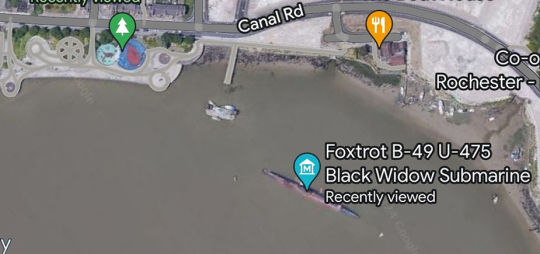
Sitting at the mound can see the Submarine
0 notes